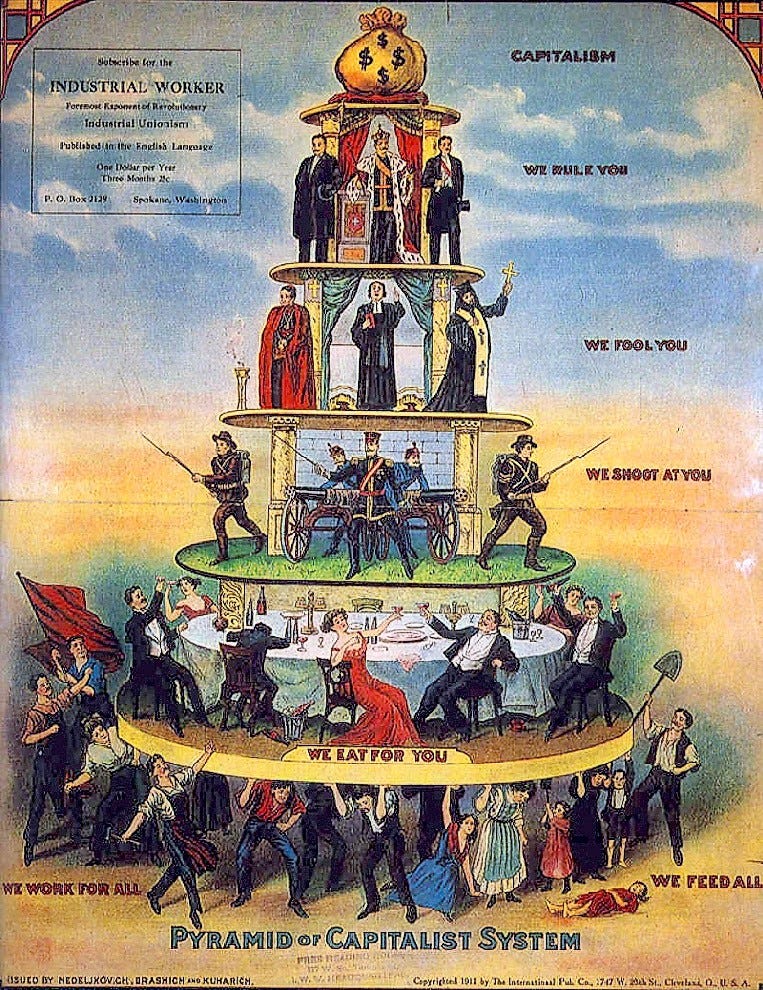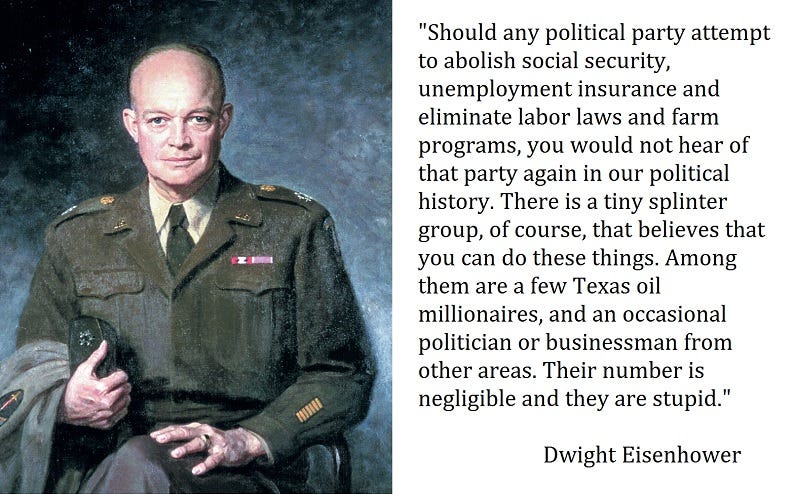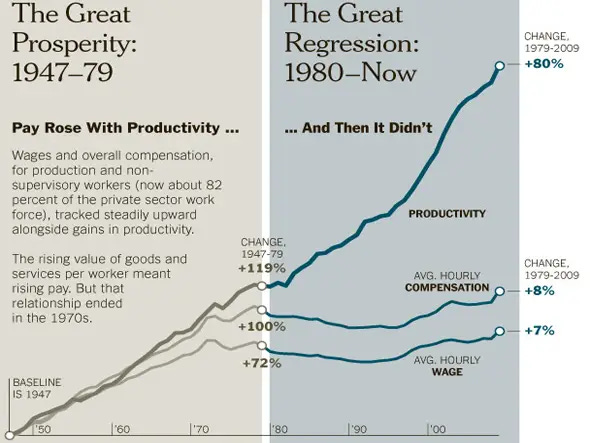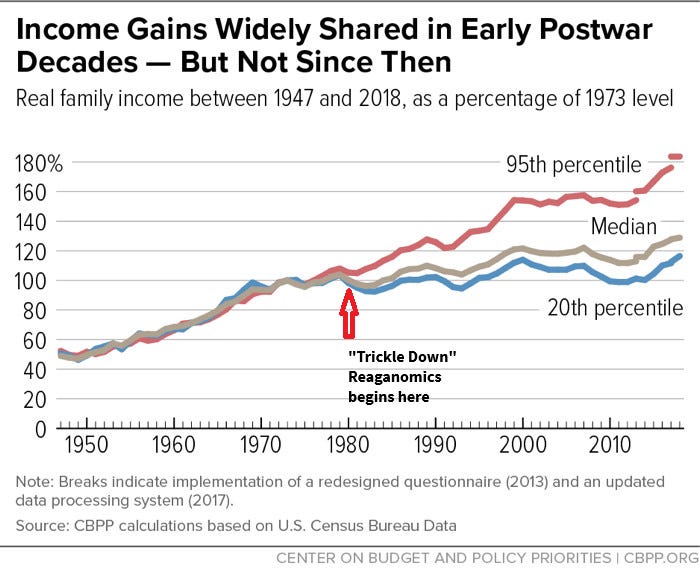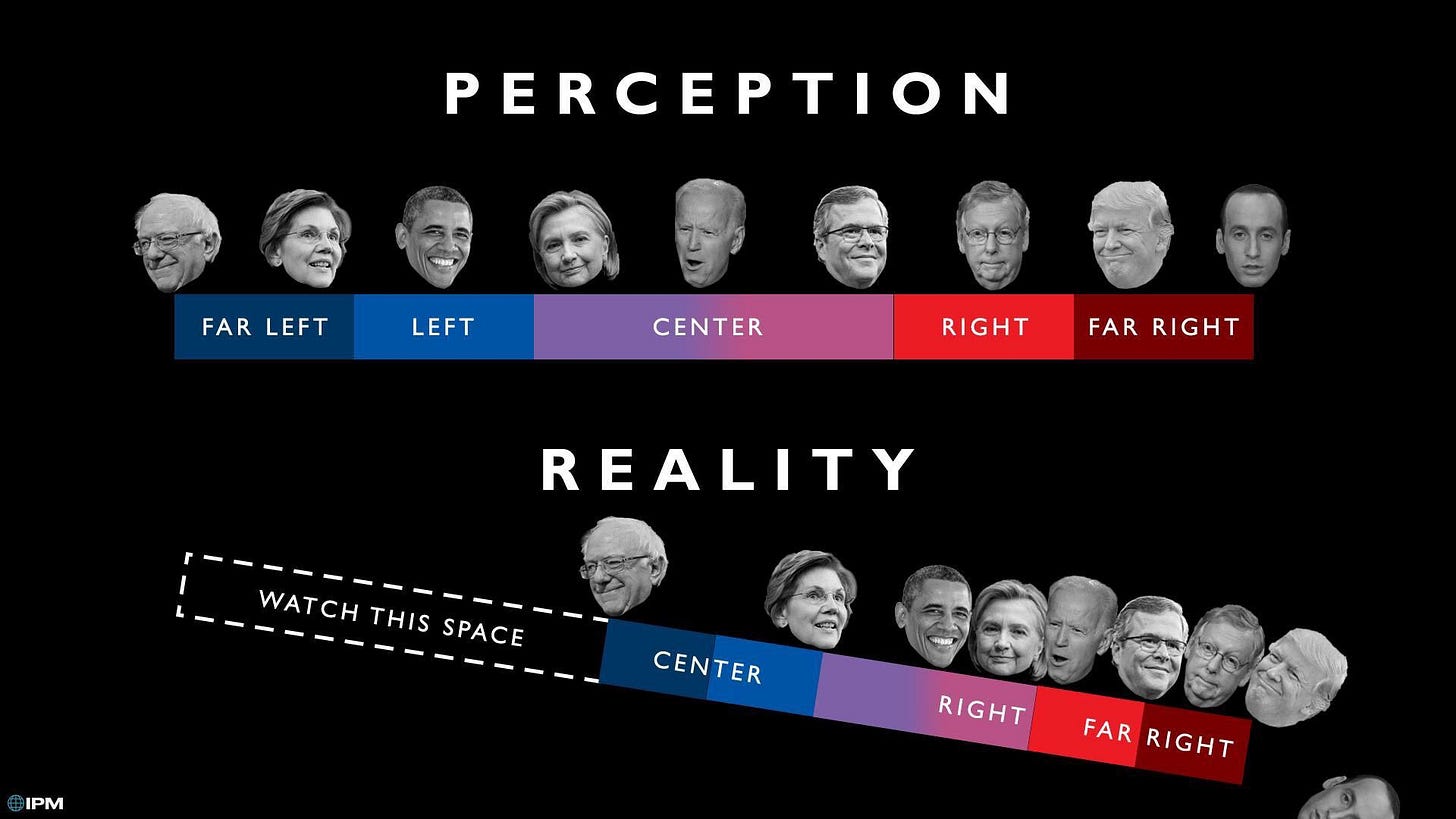In The Beginning
The middle class emerged out of medieval times and became a fixture in England and America during the Renaissance period and afterwards. Serfs became villagers, and villagers became artisans, industry workers, and skilled craftsmen. The younger siblings or children of royal peers also were relegated to the increasing business and mercantile middle class since they had no opportunity to advance into the nobility. Capitalism emerged during the industrial revolution in Europe as the dominant economic system, and spread to America, and poor immigrants were able to gain skills and upward mobility into the middle class, particularly in the North. After the American Civil War during the Gilded Age, the rich elite gained never before seen riches, and workers wages grew 40% over the period. During this time, middle class households were able to afford servants, who themselves were either children of the middle class or the poor, trying to find their way into the middle class themselves.
Yet it was also a time of poverty, especially in the South, and inequality for millions of immigrants who came to America in search of higher wages. Jim Crow laws stripped former slaves and their offspring of their rights and any power they held during Reconstruction, and politicians of the era did little to help on either side; the Democrat and Republican parties were essentially the same, and ineffectual. “From 1860 to 1900, the wealthiest 2% of American households owned more than a third of the nation's wealth, while the top 10% owned roughly three-quarters of it. The bottom 40% had no wealth at all.”
The era was not without economic upheaval, with unregulated markets leading to two depressions: the Panic of 1873 and the Panic of 1893. Bank runs, people thrown into poverty, and the rise of labor unions followed, with attempts by the rich corporate owners to put down the strikes. The Panic of 1873 is called the Long Depression because it lasted 65 months - far longer than the Great Depression of 1930s - which lasted 45 months. This culminated in 1877 with the “Great Railroad Strike.” The strike broke out because the B&O Railroad President cut wages 10%, in order to issue a 10% increase in dividends to stockholders, with expectations that the workers would continue on working with salaries that couldn’t feed their families. While the term is thought to have been coined in 1836, “wage slavery” was the position the B&O workers found themselves in July of 1877.
The railroad had unofficial militias, National Guard, Federal Troops - ordered out reluctantly by the newly elected President Rutherford B. Hays, and private militias organized by the railroad company to go up against 100,000 workers. This is the first strike that grew and extended across state lines, starting in West Virginia, and involving New York, Pennsylvania, Maryland, Illinois, and Missouri. 100 people were killed in the violence that followed. Unrepresented by unions, the strikers lost the month long struggle, and were characterized by the government and corporations as insurrectionists. Many railroad facilities and rolling stock were destroyed in the melee, rail traffic ground to a standstill, and afterwards, National Guard armories were built in major cities to guard against such upheavals again. The strike wasn’t without its benefits for the workers. Public attention on the issues of the workers caused B&O to start an Employee Relief Association to provide death benefits and some health care. In 1884, it established a worker pension plan.
1877 also was the end of Reconstruction, as the administration was not able to create a coherent policy under increasingly disapproving public opinion, and President Ulysses S. Grant stepped down after two terms in office. The nation was divided. The election that followed was a tight race between Republican Rutherford B. Hays of Ohio, and Democrat Samuel J. Tilden of New York, so tight that Congress had to form an Electoral Commission to resolve the dispute: election results were contested with 20 electoral votes disputed, including threats of political violence and a filibuster on the floor of the Senate against certification. Finally an unwritten compromise was made - if the Republicans ended Reconstruction in the South, the Southern states would agree to certify the election for Hays as President. This is known as the ‘Compromise of 1877’, the Wormley Agreement, the Bargain of 1877, or the Corrupt Bargain (one of three in US history - so far). This agreement led to Jim Crow laws in the South that set back civil rights progress for 100 years.
Unregulated growth led to a whiplash of boom and bust in the country. A prime example was Railroad building reaching its peak at this time, with many bankruptcies and funds drying up for new development - particularly in the South. Democrats won state after state in the South, and eventually control of both houses of Congress by 1879. At the same time a large influx of immigrants from Europe, and rural Americans flowed into Northern cities seeking better jobs, competing with each other for limited jobs; business owners were quick to take advantage of the glut in workers, and drove wages down, creating more enmity between workers and between workers and corporations - which drove the expansion of trade unions. Few immigrants went to the poverty-stricken South, which became even more insular.
Progressive Era - Rise of the Middle Class
All of this upheaval caused people’s thinking to evolve at the turn of the century. Not only workers started to question the status quo, people in general, and the middle class in particular, started to question the system. Progressives emerged to challenge a whole host of problems created by the industrial revolution including: the exploitation of labor and child labor, the spread of poverty and slums, political corruption, and the concentration of industrial ownership by monopolies. Multiple overlapping progressive movements formed to address the problems starting at the local level, and as they got traction, they grew to state and national level efforts.
The middle class took the lead in pushing forward changes, fighting “perceived social, political, and economic ills by advancing good democracy, scientific methods, and professionalism; regulating business; protecting the natural environment; and improving working and living conditions of the urban poor.” A key underpinning all of this activity was engagement by the middle class and poor in politics: “Direct Legislation by the Citizenship Through the Initiative and Referendum (1893)” was published by labor activist Joseph Sullivan who thought giving more political power to the working class would lead to less need for strikes, while accomplishing their goals. Progressive reformers were convinced and it became a standard reference in their work. The Direct Legislation Leagues of Oregon and California lead the way in establishing direct governance in those states.
Progressive political leaders of the time rose to power on the waves of this rising tide, the most famous being President Theodore Roosevelt. His “Square Deal” promised to break up monopolies (trusts), regulate the railroads, ensure the purity of food, drugs, and water, and conserve the natural environment, and fair dealings for the average citizen; he established many new national parks, forests, and monuments to preserve natural resources. He also established the United States as a major world power by sending the Navy on a world tour, began construction of the Panama Canal, and negotiated the end of the Russo-Japanese War. Over the course of his two terms in office, he turned more and more to the left, alienating the Republican party leadership by proposing public welfare initiatives, and criticizing business practices. Roosevelt formed his own party called the “Bull Moose” progressive party after a contentious break with the GOP during the primary which he lost - but ultimately lost the election to his mentor, William H. Taft.
Control of the national government was wrested back by business interests, but many reforms put into place during the period were either impossible to turn back, or too popular to rescind. The 19th Amendment was probably the most consequential: the vote for women was ratified in 1920. But other smaller efforts had lasting effects including: 17th Amendment requiring direct election of US Senators, adoption of the secret ballot and other reforms which nullified vote buying and election corruption, anti-trust efforts to break up monopolies - succeeding in breaking up Standard Oil in 1911, establishment of the Anti-Trust Act of 1914, and the formation of the Federal Trade Commission (FTC) (while visually impressive, didn’t have much impact on real anti-competitive practices with rare exceptions which continues to this day), 16th Amendment enacted income taxes, establishment of ‘city manager’ system made city government more efficient and less corrupt, establishment of juvenile courts and other mechanisms to keep troubled families together and keep teenagers out of adult prisons, the Pure Food and Drug act eliminated untested and dangerous patent medicines from the shelves, and the purity of food, milk, and drinking water was tackled by the cities.
Socially focused changes were also made. The most significant was the Temperance Movement - with ratification of the 18th Amendment which outlawed the manufacture, sale and transport of alcohol. Other efforts included religious efforts to regulate morals through censorship of movies, and encouragement of abstinence until marriage. The Social Gospel emerged and was adopted by most mainstream Protestant denominations, triggered by disgust with living conditions in slums, religious people thought forcibly educating children would give them talents and skills for their moral lives to improve. Compulsory education became standard practice everywhere, and not only improved their moral lives, but their economic lives as well. To be clear, the people of this era were looking at the world through the ‘rose colored glasses’ of their own experience and ethos, from the President down to the citizen on the street. Efforts were made to help former slaves and their families in the South through private organizations, and every state had political groups engaged, but nothing came of it at the national level. Racism in general, and more actively through Nativists and emergence of the KKK, and moralized finger pointing at the least able to defend themselves, continued.
Thus ended the most active era of civic engagement by the middle class.
New Deal Era - Growth of the Middle Class
As much progress as was made during the Progressive Era, it was still not enough to stave off excesses of business. The “Roaring 20’s” witnessed post WWI growth in both real goods, employment, and the stock market. What followed was massive land speculation in Florida and the first housing bubble, and stock market speculation by not only institutional investors, but small retail investors as well, all who believed the growth would never end: greed on a massive scale. Then, the perfect storm: the Florida housing bubble burst in 1926 and 1928 with two hurricanes that wiped out many properties; a precursor to the larger collapse. In mid-1929 industry started to show a downturn as sales dropped off amid an overly leveraged credit market, and money became scarce due to policy of the Federal Reserve, right at the time it was most needed. The collapse of the stock market started October 28th, 1929, Black Monday - as investors were not able to cover margin calls as stock prices dropped, and dropped, with panicked selling reaching its peak on October 29th 1929 - Black Tuesday. Thousands of investors were wiped out, and the overall economic collapse followed as banks failed and people had little to no access to money.
The only people unaffected by the Great Depression that followed were the ultra rich, who had cash reserves to cover their losses and get bargain prices on investments, as they fired workers and their factories lay idle and products accumulated unsold in storage. A number actually made money during the collapse. The middle class and poor working class suffered the brunt of the economic impacts. Families who did not become homeless did what they could to make do, building small gardens to grow their own food, repairing rather than replacing broken items, and curtailing nonessential activities. Women went to work in jobs that were deemed inappropriate for men - such as secretaries and clerks - to supplement their husband’s income. The homeless created ‘Hoovervilles’ - cardboard and scrap wood shacks on vacant land in cities - for shelter, and queued up at soup kitchens to get a meager meal, if it didn’t run out before they got to the front of the line. 13 million people became unemployed. In 1932, 34 million people belonged to families with no regular full-time wage earner.
Franklin D. Roosevelt defeated President Herbert Hoover resoundingly, after Hoover tripped all over himself in dealing with the impacts of the depression; he did not believe in federal government intervention or in government welfare, however, the problems were bigger than the states were able to deal with, or business was willing and able to handle. He doggedly held to his beliefs - but people couldn’t eat philosophical ideals. People held him personally responsible, and threats against his life were intercepted by the Secret Service.
Governor of New York at the beginning of the depression, Roosevelt, on the other hand, offered support for government intervention to help people affected and people viewed him as someone who would really try to help, boosting his popularity.
Once in office, President Franklin D. Roosevelt immediately went to work implementing his “New Deal” policies. During Roosevelt's first hundred days in office in 1933 until 1935, he introduced what historians refer to as the "First New Deal", which focused on the "3 R's": relief for the unemployed and for the poor, recovery of the economy back to normal levels, and reform of the financial system to prevent a repeat depression. From 1935 to 1938, the "Second New Deal" introduced further legislation and additional agencies which focused on job creation and on improving the conditions of the elderly, workers, and the poor. The Works Progress Administration (WPA) supervised the construction of bridges, libraries, parks, and other facilities, while also investing in the arts; the National Labor Relations Act guaranteed employees the right to organize trade unions; and the Social Security Act introduced pensions for senior citizens and benefits for the disabled, mothers with dependent children, and the unemployed. The Fair Labor Standards Act prohibited "oppressive" child labor, and enshrined a 40-hour work week and national minimum wage.
He had a number of other successful efforts, but at the beginning of WWII he had to turn his focus to the war. Republicans won more seats in Southern states at this time, and he ended up having to get bipartisan assistance to enact any laws after that, limiting his achievements. What he was able to accomplish was enough to get the middle class back on their feet, and nearly full employment during WWII did the rest. He was not able to address the key issues of big business that he saw as dangerous to society, but he did make impacts that are still felt today.
After the war, the soldiers came home, and fueled a boom that lasted until the 1970s. This was the ‘Golden Age’ of the middle class. Wages kept pace with GDP growth, and things just worked for most people. The suburbs emerged as an escape from the crowded confines of the big city, and the interstate highway system and improved roadways overall allowed people and goods to move more efficiently across the nation, and the middle class workers to travel to and from their homes in those suburbs. A whole new infrastructure evolved from that: drive through restaurants, supermarkets, and shopping malls. Life was good for the middle class.
The policies of the New Deal had impacts beyond the Great Depression, and inspired future Presidents. Between 1940 and 1980, there was the progressive consensus about the prospects for the widespread distribution of prosperity within an expanding capitalist economy. Especially Harry S. Truman's Fair Deal and in the 1960s Lyndon B. Johnson's Great Society used the New Deal as inspiration for a dramatic expansion of progressive programs. As the first Republican president elected after Roosevelt, Dwight D. Eisenhower (1953–1961) built on the New Deal. He sanctioned a major expansion of Social Security by a self-financed program. He supported such New Deal programs as the minimum wage and public housing—he greatly expanded federal aid to education and built the Interstate Highway system primarily as defense programs (rather than jobs program).
The New Deal also built a coalition that held sway over the Democratic party until the 1980s. With the 23rd and 24th Amendments (allowing citizens of Washington DC to participate in the Presidential election, and abolishing poll taxes - used by Southern states to keep poor and minorities from voting), the Voting Rights Act of 1965, and the Civil Rights Acts of 1964 and 1968, the government attempted to address the structural racism that extended from the Compromise of 1877, and ended Jim Crow laws in the South. This wasn’t because of the good intentions of white folks, but because thousands of black people were marching and taking actions of social disobedience to those laws, and 250,000 people assembled in Washington DC at the Lincoln Memorial to hear Reverend Martin Luther King speak.
And with that, the Middle Class drove back to their suburbs, and went to sleep. They were fat, dumb, and happy living in a world that hadn’t changed since before they were born.
New Gilded Age - Fall of the Middle Class
On January 20th 1981, President Ronald Reagan took the oath of office, and ushered in a new era that would begin to dismantle much of the progress made in the previous hundred years.
Actually it really began 10 years earlier, in 1971: President Richard Nixon had a problem; productivity and employment were up, but also inflation. High inflation led to high costs, and people would blame him for this - which he was afraid would impact his election to a second term. He was concerned about how to fix this, and called in his advisors to give him options. In 1970 a Democrat majority Congress had given the president the power to engage wage and price freezes, not thinking Nixon would use them. This gave him the tool he needed: Nixon issued Executive Order 11615 pursuant to the Economic Stabilization Act of 1970, unilaterally imposing 90-day wage and price controls, a 10% import surcharge, and most importantly "closed the gold window", making the dollar inconvertible to gold directly, except on the open market. This had the desired effect, and he was elected to a second term. However inflation returned after the Watergate affair and was something Gerald Ford would have to deal with.
Concurrent with the United States and the rest of the world going off the gold standard, the Chicago School of Economics at the University of Chicago was busy working on new ideas, and among them was a new philosophy of business, in the person of Professor Milton Friedman and in the form of the “Friedman Doctrine” introduced in a New York Times essay: A Friedman Doctrine: The Social Responsibility of Business is to Increase Its Profits. In it, he argued that a company has no social responsibility to the public or society; its only responsibility is to its shareholders. This went over like gangbusters, and every corporation latched onto this like it was the holy grail. Greed is good.
So the middle class started to suffer, but it was a slow bleed that wasn’t really felt right away. As with all economics, it is not really a science because of the myriad factors involved (people). But, one thing stands out to me about this era: people were willing to monkey around with things, and reframe them, even or maybe especially if they didn’t understand them. Somehow wages get decoupled from productivity in 1971 and here we are with Ronald Reagan taking the oath of office.
President Reagan immediately began to implement his policy called ‘Reaganomics’. It was very simple at a glance: deregulate everything, and give subsidies to corporations in the form of tax cuts. He argued that the benefits of giving money to corporations, and the rich was they would create more jobs and the money would ‘trickle down’ to the workers. During his time in office, wages further lost ground, productivity was up though. He failed in his goal to lower government spending, and the federal deficit tripled during his presidency. His presidency signaled more things to come. I wonder where all that money went that wasn’t paid to workers? Trickle down economics was a bust, and I bet you can tell where all the money went.
As I stated in a previous article, we can mark the dissolution of the New Deal coalition at the point at which Bill Clinton is elected in 1992, replacing the New Deal coalition with the neo-liberals of the New Democrats. The New Democrats cozied up with corporate moguls by being for laissez-faire capitalism, while being culturally liberal. They abandoned unions which collapsed, the poor, and the middle class. Everyone at the time said this would be a good thing, because what was really important were these unresolved social issues; we were all good economically, right? So the middle class just went along with it, largely without comment because they were still doing okay, or so they thought. Milton Friedman argued: “relationships between companies and workers are purely voluntary and mistreated workers will seek better treatment elsewhere. Thus, most companies will compete for workers on the basis of pay, benefits, and work-life balance just as they compete with one another in the marketplace on the basis of the relative cost and quality of their goods.” In practice this did not happen, and wages stagnated and benefits dropped, and costs went up for the middle class and working class, and like a frog slowly being boiled in water - they were in hot water before they knew it.
The middle class was overextended on credit, holding large mortgages when the housing bubble created by predatory lending practices, enabled by deregulation in prior administrations allowing sub-prime lending to low income families, burst in the financial crisis of 2007-2008. This culminated in the bankruptcy of Lehman Brothers, who held a large amount of these subprime notes, and an international banking crisis. This came to be known as the Great Recession. Median household wealth fell 35% in the U.S., from $106,591 to $68,839 between 2005 and 2011. A report showed that the distribution of household incomes in the United States became more unequal during the post-2008 economic recovery, a first for the United States but in line with the trend over the last ten economic recoveries since 1949. Income inequality in the United States grew from 2005 to 2012 in more than 2 out of 3 metropolitan areas.
In December 2019 the Covid Pandemic launched a world wide blow that further exacerbated the slow decline in the middle class. The stock market crashed, and retail investors took a hit far worse than institutional investors. Retail stores took the biggest hit losing 50% of foot traffic, and shopping centers - already reeling - lost 33% to 43% drop in traffic, pushing many over the edge. 40 million jobs were lost in the USA alone. 60% of the businesses that closed during the pandemic would not reopen. All of this made worse by President Trump’s failure to react to the pandemic appropriately.
Where Do We Go From Here?
Today young middle class families are decimated; most families must have both partners work in order to just make ends meet. Getting ahead is a distant dream. Buying a home is out of the question. Many young people are putting off building families or even having partners because the costs are just too high to have a family. Meanwhile a massive transfer of wealth has been concentrated in a few rich billionaires, who use their money to maintain and increase their power and suppress unions and workers. (In comparison to the Gilded Age, today wealth is concentrated even more for those at the top, and while declining for those in the middle: the top 1% own 30.2%, the top 49% own 67.3% with the bottom 50% owning 2.5%.)
The New Democrats failed us by infiltrating the Democratic Party with right wing economic policy. Between them and the Republican Party’s failed policies and aggressive deregulation, we are fast returning to pre-New Deal policy. Given Project 2025 and the impending Trump second administration, we are probably looking at going back to pre-Progressive Era “Gilded Age” policy, which was basically no policy at all, every man, woman, and child for themselves.
The past speaks to us. If we examine what is happening today in comparison to the past we see common themes. The rich take advantage of the working & middle class when the we fail to organize and form unions. The rich and the right wing characterize the working class as lazy and unworthy of a living wage. So what if they have to work two or three jobs to make ends meet? That’s just the market forces, right? The laws and system put in place benefits the rich at the expense of the middle and working class; medical insurance is a prime example. The rich tell lies about themselves to justify their being at the top: self made man, meritocracy, entrepreneurial and pioneering spirit, and ultimately white exceptionalism and racism underpinning it. All lies. The rich have always had the power to fix things and make sure wealth is distributed evenly, yet they refuse to use their incredible resources to do it.
The past also shows us when the middle class is most successful: when the middle class bands together, organizes and votes together for progressive values and policies. This leads to a broad distribution of wealth that benefits everyone. The middle class is the glue that holds the nation, and our democracy, together. I think there are a number of things that history tells us, that we should take under consideration when we think about what to do next and in the coming months:
America was best when the middle class stood together and fought for progress, especially at the ballot box, and in the union halls and streets if necessary. We must get engaged and work together. If we don’t they will take advantage of us as has been happening since the 1970s.
We need to regain consensus that progressive policies help the most people and are best for America, and conservative policies only serve the rich upper class. In fact right wing terminology is almost always code for doing the opposite: “conservatives” conserve nothing except money for the rich, “trickle down” never trickles anywhere but into the bank accounts of the rich, “great” as in “Make America Great Again” really means inferior, “speech” equals money, and “corporation” equals person. None of that is true. Progress from the 1890s to the present has been responsible for expanding human rights and built the greatest nation in the world; conservatism has been about taking away human rights and building an oligarchy.
The New Democrats push to the middle, is really the flip side of the conservative coin - designed to help the rich and exploit the middle class. We need to remember this when deciding who to engage as allies in our cause. Are the politicians we engage really for the middle class and equal distribution of wealth, or are they elites feigning support for ‘the people’ via exploitation of social liberalism in culture wars that didn’t effectively impact the economic status quo. For success in the future, the middle class must insist the Democratic Party stop lip service to the needs of the middle class, poor, unions, and aggressively attack neo-liberalism and economic inequity across the board. Failing to reform the Democratic Party, the middle class needs to strike out on our own and build our own coalition of like minded people who want a holistic policy menu that focuses on the right things to save our democracy and ensure economic equality.
Finally, as a key part of these efforts, we must be committed to eliminating racism, infighting, and any remaining hint of white exceptionalism, white nationalism, and christofascism. There is no place for this in America, and it is a direct threat to the Constitution, democracy, and freedom. It can not be allowed to be mainstreamed; we must not tolerate intolerance.
The Middle Class is the glue that holds this nation together. Let’s make sure we are strong enough to hold in the coming struggle.





